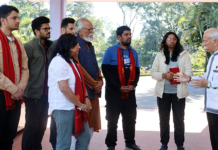[ Dr Anjan Chamuah ]
In today’s era of globalization and technological innovation, it is paramount to prioritize the wellbeing of our society, economy, culture, and environment. The values inherent in our social, economic, environmental, and cultural fabric contribute significantly to our quality of life. It is crucial to preserve and conserve these values to effectively achieve the United Nations Sustainable Development Goals (SDG). The 17 interconnected SDGs have multiple priorities, aiming to tackle challenges ranging from persistent poverty, chronic hunger, gender-based violence, malnutrition, climate change, economic inequalities, and conflicts, among others.
The balance between innovation and sustainability
Sustainability and innovation are like two sides of the same coin. To achieve the goal of environmental sustainability – conservation, protection, and preservation – innovations are essential to secure our future resources. Sustainable development means meeting the needs of the present without compromising the ability of future generations to meet their needs. On the other hand, innovation often creates disruption and discontinuity, which can lead to the extinction of some actors, conflicting with the sustainability goals of preservation and conservation for the future. Therefore, innovation and sustainability can sometimes seem paradoxical. However, the framework of responsible environmental innovation encompasses sustainability from ethical, societal, environmental, and economic perspectives, making it more robust and compatible with both innovation and sustainable development.
Bridging sustainability and progress
Environmental innovation is broadly defined as innovations in new processes, techniques, practices, systems, and products to avoid or reduce environmental harm. It is implementation of new ideas, technologies, strategies, and practices aimed at addressing environmental challenges and promoting sustainability. Environmental innovation plays a crucial role in addressing global environmental challenges such as climate change, resource depletion, pollution, and biodiversity loss. It involves collaboration among scientists, engineers, businesses, governments, and communities to create solutions that balance environmental sustainability with economic development and social wellbeing.
A green paradise under threat
In order to protect the biosphere, fostering of society and economy is crucial. Environmental innovation is critical in Arunachal Pradesh, where 5.15 million hectares (79.33% of the land) is covered by forests. Additionally, 80% of the rural population depends on agriculture, with approximately 62% of the total workforce engaged in this sector (Government of Arunachal Pradesh, 2017).
However, it has been observed from previous studies that there are enormous threats to biodiversity, which include habitat fragmentation, illegal poaching, habitat reduction, and recently climate change. Another major factor causing biodiversity loss in Arunachal is unsustainable harvesting of wildlife(Jyrwa et al, 2020).
Innovative solutions
Environmental innovation can be promoted in Arunachal through implementation of renewable energy technologies, circular economy, effective waste management, smart agriculture, carbon market, and biodiversity conservation. Arunachal has significant potential for renewable energy development due to its abundant natural resources, which include hydropower, solar energy, wind energy, and biomass energy. Innovations that promote a circular economy by designing products for durability reuse, remanufacturing, recycling, and minimizing waste and resource consumption can boost the economy along with promoting sustainability.
Effective waste management is crucial for preventing environmental hazards. The introduction of advanced technologies and strategies for efficient waste collection, sorting, recycling, and waste-to-energy conversion is significantly reducing landfill waste and environmental pollution. Innovations in precision agriculture, sustainable farming practices, and technologies that optimize water and nutrient use reduce pesticide use and promote soil health, and can promote smart agriculture in Arunachal.
Jhum cultivation and terrace farming are the primary agricultural practices in Arunachal. Most agricultural operations are carried out using manual labour or animal power. As a result, there is significant potential for selective mechanization. Introducing improved hand tools such as advanced sickles, dibblers, and weeders can help reduce the physical strain on farmers. Additionally, mechanizing seedbeds preparation by promoting the use of animal or power-tiller-drawn equipment could greatly enhance efficiency of the agriculture sector.
Furthermore, innovations in habitat restoration, species conservation, and ecosystem management to protect and restore biodiversity can promote biodiversity conservation.
Another technique to preserve the atmosphere is the implementation of carbon credit market to reduce the greenhouse gas emission as prescribed in Article 6 of the Paris Agreement, 2015. Through the carbon credit market, the state can contribute to the nationally determined contributions, control pollution, protect biodiversity, reduce ozone layer depletion, and promote SDGs.
Harnessing indigenous knowledge
Additionally, promoting practices like the symbiotic rice-fish farming among the Apatani tribe in Ziro Valley not only conserve the environment but also enhance the age-long culture-specific values of the community. In this indigenous farming system, rice paddies are combined with fish ponds to maximize both crop yield and fish production, contributing significantly to the community’s food security and income. Fish in the paddies naturally fertilize the crops, control pests, and boost rice yield without the use of chemical fertilizers or pesticides. This approach not only ensures higher productivity but also helps maintain ecological balance, energy efficient and promotes soil fertility through organic practices.
Collective effort for a sustainable future
Arunachal, with its rich biodiversity, cultures and traditions, stands at a critical juncture where the balance between development and conservation must be carefully managed. The state’s heavy reliance on agriculture, including practices like terrace and jhum cultivation, underlines the need for sustainable approaches to ensure the livelihoods of its people while protecting the environment. The emerging threats from habitat fragmentation, illegal poaching and climate change pose significant challenges not only to the state but also to the broader goals of the United Nations Global Agenda 2030 and India’s Mission LiFE (Lifestyle for Environment) objectives.
Addressing these issues requires a collective effort where every stakeholder plays a role in safeguarding natural resources. By adopting the framework of responsible environmental innovation, where accountability and collaboration are prioritized and ethics and values are preserved, Arunachal can lead by example in contributing to a safe, smart and greenIndia. This approach will not only secure the future for the state’s residents but also align with the global sustainability goals, ensuring that the natural beauty and ecological wealth of Arunachal are preserved for the generations to come. (The contributor is Programme Officer, Department of Environment, Forest & Climate Change, Govt of Arunachal Pradesh.)




